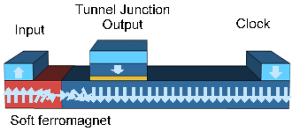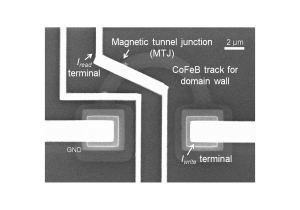Research
Magnetic Domain Wall Devices
Figure: (left) Cartoon of the magnetic domain-wall device. (right) Microscope image of a fabricated magnetic domain-wall device prototype.
We focus on building digital logic with spintronics as a solution to overcome one of the greatest weaknesses that has emerged in conventional field-effect transistor logic—their power dissipation. We argue that to be robust against noise, all switches should exhibit an energy difference between their ON and OFF states. For example, the potential energy difference between the ON and OFF states of a conventional field effect transistor is ΔE = ½CV2, which can also be expressed as ΔE = ½QV, where Q is the total charge on the gate capacitor, C, and V is the supply voltage. The fundamental limit in the OFF state current is the probability of thermal excitation from the OFF state to the ON state. That is:
where ION is the maximum current associated with the ON state. But devices do not operate at this limit because each electron in the channel is independent. The actual ON-OFF ratio is determined by:
where q is the charge of a single electron. Thus, in order to achieve a given ratio of IOFF/ION the operating voltage of modern devices is increased beyond theoretical limits by a factor of approximately Q/q. At present transistor dimensions Q >> 103 q, leading to substantial increases in the voltage and dynamic power.
Our solution to this problem is to look for systems where information is stored in a collective phenomenon. For example, instead of using a transistor where every conducting charge is independent, we are interested in states such as the domains of ferromagnets. Strong interactions in these systems, align electron spins collectively. We have been working to translate these phenomena into practical, concatenable digital logic circuits.
In addition to our designs of computing systems with magnetic logic, we also investigate material effects that affect the operation of the magnetic logic device.
For further reading about our device, check out our publication: Currivan et al, IEEE Magnetics Letters 2012.



